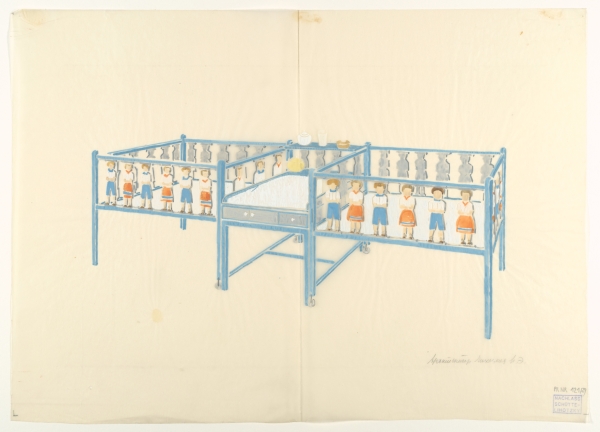Moscow Material
Margarete Schütte-Lihotzky’s
Designs for Children’s Furniture
Margarete Schütte-Lihotzky, Krippenmöbel, 1935–37, IN: 121/29
Margarete Schütte-LihKunstsammlung und Archiv, Universität für angewandte Kunst Wien / Bildrecht, Wien
2025
An exhibition by the Collection and Archive
University of Applied
Arts Vienna
“I’m working a lot at the moment, but very happily in the comfort of my home. I'm taking part
in a paid competition (there are two other competitors apart from me, both Russian) to design a childcare centre (100 crèche
children and 140 kindergarten children) for the children of engineers from the War Academy, which is to be built here in Moscow
in the summer. It’s a really nice task, but unfortunately it’s on a rather inconvenient building site in the middle of the
city. The deadline is 25 November, so I still have a lot of work to do as it has to be beautifully presented ... Whoever wins
will get a cash prize too, which will mean either a new fur coat or a trip to Vladivostok and back for me. Then afterwards,
I have two books to work on, one about kindergartens, one about crèches ...”
(Letter from MSL to Adele ‘Dele’ Hanakam,
30 Oct. 1933, MSL1933-10-30, p. 2–3)
In 1930, Margarete Schütte-Lihotzky (1897–2000) left Frankfurt
am Main together with her husband Wilhelm Schütte and numerous members of the "Ernst May Brigade" for the USSR, where she
worked at the Moscow Architectural Institute under Hannes Meyer until she left for Paris in 1937. In addition to numerous
designs for model flats and kindergartens, children's sanatoriums and school buildings – projects which she was partly managed
– from 1935 to 1937, she concentrated primarily on creating detailed designs for children's furniture and a model design for
crèches.
The materials for these furniture designs now preserved in the Collection and Archive were originally intended
for two projects that never came to fruition: a research project with designs for standardized furniture for the care of infants
in crèches and a scientifically supported model project with children's furniture for apartments. The latter includes ideas
which were to be presented in the form of a sample exhibition (which was also never saw the light of day), for which Schütte-Lihotzky
numbered her designs and grouped them into clusters, as well as categorizing them by age group and level of need. These notes
are supplemented by short explanatory texts written by the architect herself.
On the 25th anniversary of
Schütte-Lihotzky’s death and following the successful monographic exhibition curated by Bernadette Reinhold and Stephanie
Buhmann for the Austrian Cultural Forum in New York in 2024, the Collection and Archive Institute will examine her work through
a close reading of these two case studies. The exhibition Moscow Material uses the architect’s own writings to provide
the first in-depth look at the sketches, preliminary studies, (detailed) plans and visualizations of the designs for children's
furniture. In addition, numerous photographs of the architect from her time in Moscow as well as archive documents, letters
and postcards provide a visual commentary on the construction of the USSR in the 1930s from her perspective. The initial design
process for the children's furniture took place during the period known as the “Great Terror”, making it particularly revealing
in terms of political and social tensions. As both visual and verbal statements, these designs and ideas not only allow us
to understand Schütte-Lihotzky's private and public conception of design, but also to visualize the complex political and
social demands of her position.
This exhibition runs alongside the continued cataloguing and study of the architect’s
legacy – which comprises over 10,000 objects – currently underway as part of a digitization project at the Collection and
Archive.
The program accompanying the exhibition takes place in cooperation with the Margarete Schütte-Lihotzky
Zentrum.
Opening Hours: Wednesday – Saturday: 2 – 6pm, closed on public holidays
Concept and Exhibition
Design: Robert Müller
Overall Management: Cosima Rainer
Exhibition Management: Judith Burger, Anja Seipenbusch-Hufschmied
Digitization project: Silvia Herkt, Bettina Buchendorfer
Margarete Schütte-Lihotzky, Krippenmöbel, 1935–37, IN: 121/29
Margarete Schütte-LihKunstsammlung und Archiv, Universität für angewandte Kunst Wien / Bildrecht, Wien
2025
Events
Opening
07. March 2025 - 18:00
Universitätsgalerie der Angewandten im Heiligenkreuzerhof,
Schönlaterngasse 5 / Grashofgasse 3, 1010 Wien
Duration
08. March
2025 - 05. April 2025
Universitätsgalerie der Angewandten im Heiligenkreuzerhof, Schönlaterngasse
5 / Grashofgasse 3, 1010 Wien




